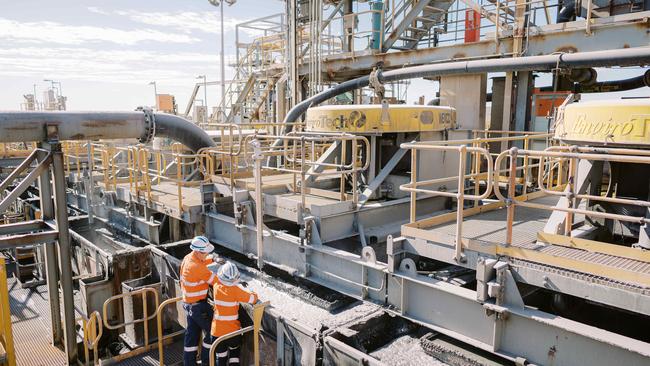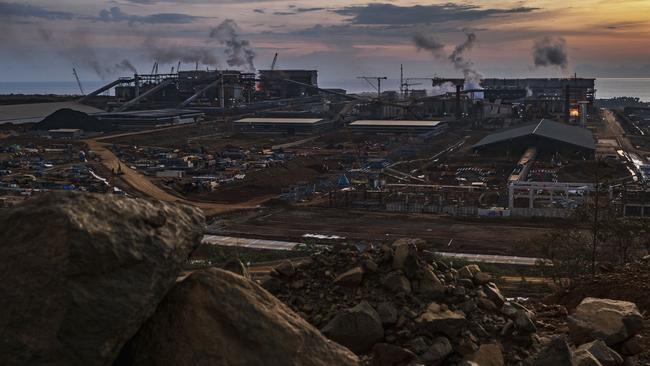Entire Aussie industry on the brink amid China move
The commodity is meant to be the answer to the green revolution but it’s on the brink of collapse and Australia is in the firing line.
Mining
Don't miss out on the headlines from Mining. Followed categories will be added to My News.
Analysts believe up to half of the world’s nickel mines are unprofitable at current prices.
And those prices are unlikely to change anytime soon.
That has profound implications for Australia’s multinational miner, BHP.
While nickel is only a minor component of its overall portfolio, the “Big Australian” had high hopes for the critical mineral’s future. It’s a key ingredient in advanced batteries and high-efficiency electric motors. And both are crucial in the race to limit the impact of CO2-induced climate change.
Successive Australian Federal Governments have also been touting the ambition to become a global green-battery supplier. After all, every rare – and critical – component can be mined Down Under. So why not smelt it? And build the end products ourselves?
Indonesia has the same ambition.
But it’s bolted from the starting blocks, leaving Australia in its coal-fuelled smoke.
Indonesia’s new China-built and operated nickel processing industry is pricing out all competition. It was $43,000 a tonne a year ago. Now it’s $25,000 a tonne.

And Indonesia is now producing more than half the world’s supply. Its mines and smelters generated 200,000 tonnes in 2016. That leapt to 1.8 million tonnes last year.
Meanwhile, the “green economy” premium competing producers had hoped to pin on their inevitably more expensive clean product has failed to eventuate. European electric vehicle manufacturers are already moving to demand that all suppliers cut costs in the face of cheap new Chinese imports.
Winner takes all
Australia was the world’s fifth largest nickel producer in 2022, accounting for about 6 per cent of global production.
That’s all changed.
And that leaves Australia’s biggest producers – Glencore and BHP – on the brink of shuttering their operations here and overseas.
Australia’s biggest nickel operations are the Murrin Murrin, Nova Bollinger, Leinster, Ravensthorpe, Cliffs, Spotted Quoll, Beta Hunt, Mount Keith, Odysseus Project, and Flying Fox mines. And they’re all in WA. All are having their futures reviewed.

Then there are those in development.
WA’s Honeymoon Well, Wingellina, West Musgrave, Canegrass, Clean TeQ Sunrise, NiWest, Goongarrie, Kalgoorlie and New Morning – and Queensland’s Brogla Stage 2 – are all having their feasibility studies reassessed.
Investing analysis firm Macquarie estimates some 35 per cent of global nickel mines became unprofitable at $27,500 a tonne. If it falls to $23,000 a tonne, that figure rises to 75 per cent.
This week, BHP’s CEO Mike Henry admitted the company will have to make these hard decisions within months. And he says he can’t foresee any improvement in the market before the end of the decade – unless global standards change.
Earlier this week, BHP submitted a call to the London Metals Exchange to tighten environmental due diligence policies and call out producers willing to pay high environmental costs to supply cut-price minerals.
Brown revolution
Low-grade nickel has generally been used in bulk stainless steel production. It’s a necessary ingredient in giving the alloy its crucial resistance to corrosion.
High-grade nickel is mainly reserved for advanced battery manufacturing. It’s rarer to find.
But Indonesia’s glut of low-grade nickel has made it viable for Chinese-controlled smelters to expend the considerable energy needed to refine it further.
And they’ve built several new coal-fuelled power plants in Indonesia for that specific purpose.
It’s all just part of a larger plan for Indonesia to build an advanced economy.
It wants nickel – among many other resources – to build new electric vehicles and advanced battery manufacturing industries.

Unlike Australia, Indonesia has secured the international investment needed to do so.
Chinese banks operating under Chairman Xi Jinping’s “Belt and Road” strategy have poured loans into the project. Chinese state-owned and controlled enterprises have also taken controlling stakes in infrastructure development and production operations.
But not everything is going to plan.
“Downstreaming policies have fallen short of establishing Indonesia as a global lithium-ion battery manufacturing capital,” Indonesia analyst Amy Mance argues in the Australian Institute of International Affairs.
And that’s one industry China’s not eager to offshore.
Profits at any cost?
Electric vehicles are only as clean as the electricity powering them. They are only as green as the production chain that produced them.
And the same applies to solar panels, wind turbines, nuclear power plants – and nickel.
However, cutting CO2 emissions and avoiding pollution in the processes traditionally needed to extract low concentrations of critical minerals is expensive.
Some nations, however, feel compelled to pay an environmental price.
“Take Obi Island, a small and nickel-rich island located in the North of the archipelago, near the Maluku province,” says Mance. “Carcinogenic chemicals have invaded the island’s water streams, decimating fish populations and restricting the income-generating capacity of local fishermen. Indeed, residents of Obi Island can now seek employment in local nickel refineries, but is the cost of this, the erosion of traditional cultural practices, worth it?”

But Indonesia argues it has been left behind by decades of “imperial” international trade policies that have prevented it from modernising its economy. And it’s found China – the world’s second-largest economy – harbours the same resentment.
And their willingness to refine “dirty” rare and critical metals, such as lithium and nickel, gives them global leverage.
“As highlighted by Indonesia, the geopolitical landscape of critical minerals is evolving,” argue Australian Strategic Policy Institute (ASPI) analysts John Coyne and Henry Campbell. “Nations are strategically positioning themselves to be important suppliers of critical minerals, as well as ensuring stable and secure supply of these essential elements for their economic and technological advancement.”
Jamie Seidel is a freelance writer | @JamieSeidel
Originally published as Entire Aussie industry on the brink amid China move





